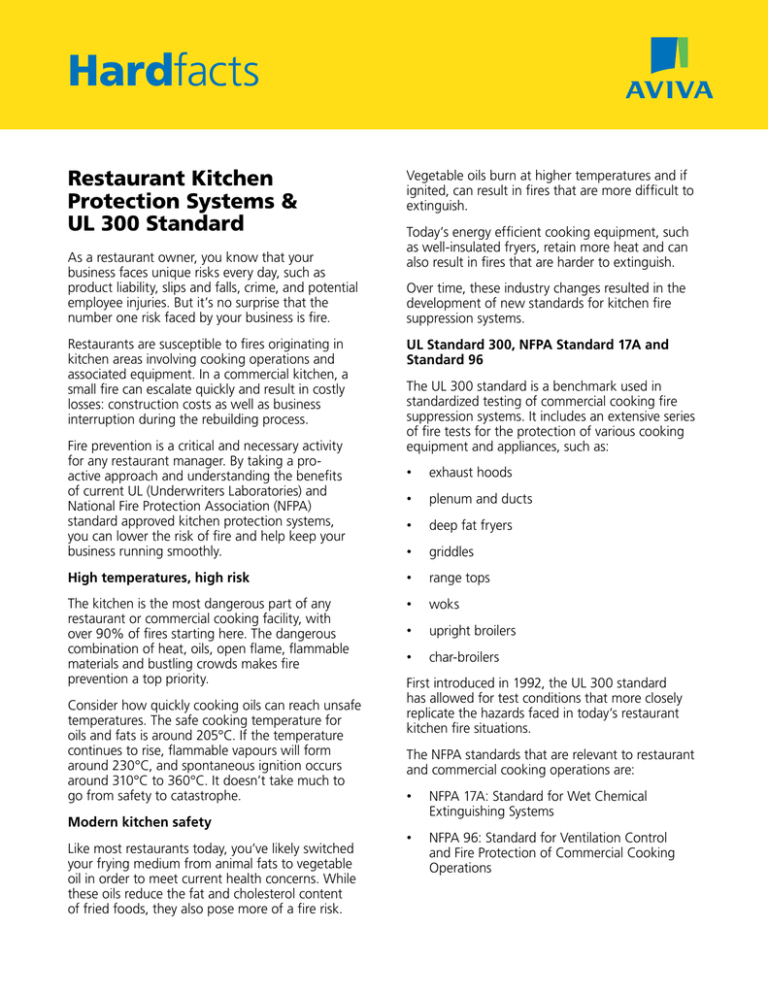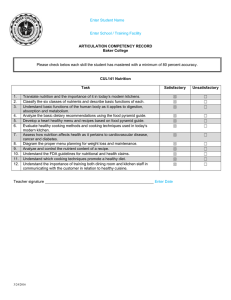
Hardfacts
Restaurant Kitchen
Protection Systems &
UL 300 Standard
As a restaurant owner, you know that your
business faces unique risks every day, such as
product liability, slips and falls, crime, and potential
employee injuries. But it’s no surprise that the
number one risk faced by your business is fire.
Restaurants are susceptible to fires originating in
kitchen areas involving cooking operations and
associated equipment. In a commercial kitchen, a
small fire can escalate quickly and result in costly
losses: construction costs as well as business
interruption during the rebuilding process.
Fire prevention is a critical and necessary activity
for any restaurant manager. By taking a proactive approach and understanding the benefits
of current UL (Underwriters Laboratories) and
National Fire Protection Association (NFPA)
standard approved kitchen protection systems,
you can lower the risk of fire and help keep your
business running smoothly.
Vegetable oils burn at higher temperatures and if
ignited, can result in fires that are more difficult to
extinguish.
Today’s energy efficient cooking equipment, such
as well-insulated fryers, retain more heat and can
also result in fires that are harder to extinguish.
Over time, these industry changes resulted in the
development of new standards for kitchen fire
suppression systems.
UL Standard 300, NFPA Standard 17A and
Standard 96
The UL 300 standard is a benchmark used in
standardized testing of commercial cooking fire
suppression systems. It includes an extensive series
of fire tests for the protection of various cooking
equipment and appliances, such as:
•
exhaust hoods
•
plenum and ducts
•
deep fat fryers
•
griddles
High temperatures, high risk
•
range tops
The kitchen is the most dangerous part of any
restaurant or commercial cooking facility, with
over 90% of fires starting here. The dangerous
combination of heat, oils, open flame, flammable
materials and bustling crowds makes fire
prevention a top priority.
•
woks
•
upright broilers
•
char-broilers
Consider how quickly cooking oils can reach unsafe
temperatures. The safe cooking temperature for
oils and fats is around 205°C. If the temperature
continues to rise, flammable vapours will form
around 230°C, and spontaneous ignition occurs
around 310°C to 360°C. It doesn’t take much to
go from safety to catastrophe.
Modern kitchen safety
Like most restaurants today, you’ve likely switched
your frying medium from animal fats to vegetable
oil in order to meet current health concerns. While
these oils reduce the fat and cholesterol content
of fried foods, they also pose more of a fire risk.
First introduced in 1992, the UL 300 standard
has allowed for test conditions that more closely
replicate the hazards faced in today’s restaurant
kitchen fire situations.
The NFPA standards that are relevant to restaurant
and commercial cooking operations are:
•
NFPA 17A: Standard for Wet Chemical
Extinguishing Systems
•
NFPA 96: Standard for Ventilation Control
and Fire Protection of Commercial Cooking
Operations
Complying with the UL 300 standard
For further information on this topic, please contact your
independent insurance broker.
Today, all newly manufactured fire protection
systems for commercial cooking must comply
with UL 300 to qualify for a UL listing label. It
is also a requirement of NFPA 96 that these fire
extinguishing systems comply with UL 300.
To make sure your business is compliant, check
with UL that the model number is listed as UL
300, and that all components have been installed
according to the manufacturer’s instructions. Other
indicators that your system may not be compliant
include the use of a dry chemical agent, or a single
nozzle designed to protect multiple appliances.
Exiting non-compliant fixed extinguishing systems
installed prior to July 1, 1995 must be upgraded to
meet the requirements of UL 300. Existing
pre-UL 300 wet chemical systems may be
upgraded at minimal expense, as most will need
only more capacity for the wet chemical agent.
The dry chemical system failed the UL re-ignition
test and cannot be upgraded. Currently, no dry
chemical system has been listed under UL 300.
You don’t need to modify or upgrade an
existing pre-UL 300 system if you are not using
vegetable oil for cooking or frying, as long as the
manufacturer’s listing requirements are maintained.
Any restaurant fire protection systems listed prior
to the implementation of the new UL 300 are
not considered unlisted. However, if you have a
dry chemical systems that is unable to meet the
new UL 300 standard, it’s recommended that you
replace the existing system with an approved UL
300 wet chemical system.
Summary
The UL standard 300 has advanced the fire
protection capability available to restaurants and
commercial cooking operations.
It’s critical that commercial cooking operators &
restaurant owners are aware that dry chemical
systems, where vegetable oils are being used, must
be removed and replaced to protect their business
investments, and most importantly their customers
and employees.
For more information on other loss control topics, visit
www.avivalossprevention.com
Hardfacts information sheets are designed to give general
information on risk management topics. Readers should take specific
advice when dealing with particular situations. Aviva Canada Inc.
accepts no responsibility for action taken as a result of information
contained in this publication. The information in Hardfacts
information sheets is correct at the date of going to press. Printed
and published by Aviva Canada Inc., Website: www.avivacanada.com
© Copyright, all rights reserved. Aviva is a registered trademark of
Aviva plc and used under license.


